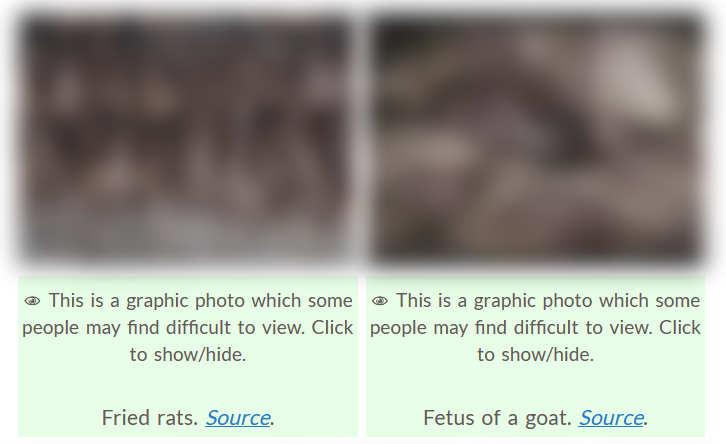How can I provide ample warning and an opportunity for learners to bypass content that may be upsetting?
Providing a statement to your students prior to revealing potentially distressing content is a useful way to help reduce its negative impact.
The content may be delivered via:
- text,
- verbal narratives,
- URLs,
- images,
- figures,
- visuals,
- video,
- audio, or
- interactive activities.
A general guide is that if you find yourself pausing when adding particular content to your course; ask yourself if including it is necessary. If it is, consider a content warning. This also show students that you care about their wellbeing and safety.
Sensitive Topics
Topics often identified as potentially sensitive include, for example,
- violence or abuse of all kinds:
- physical,
- emotional,
- sexual, or
- institutional;
- racism;
- homophobia;
- transphobia;
- eating disorders; or
- self-harm.
You can find lists of types of material that may benefit from a content warning on the Internet. Here are two to get you started:
- Taylor, Pink & Hannah. (c. 2022). A Tumblr for Trigger Warnings, alphabetical
- Annemieke. (2019, September). A (Small) List of Trigger Warnings You Can Use, by category
Assistance
For those who have been adversely affected by course content, or other life experiences, students can access the Student Wellness and Counselling Centre, and instructors may avail of their Employee Assistance Program (EAP) services.
Approaches to Presenting Content Warnings
There are a few approaches to use to bring sensitive content to students attention, syllabus fair warning statement, a verbal reminder prior to sensitive material may be presented, written warning statements within course notes (physical or online), or visual/text warnings on content pages of online materials. A few examples are noted below.
Statement of Fair Warning in Syllabus
The Syllabus Resource on the Instructional Resources site, composed by the Memorial University Syllabus Working Group, recommends including a Statement of Fair Warning; see section 3. Course Information. The example they provide is:
Statement of Fair Warning. Outline content that may be personally offensive or otherwise troubling. Include instructions for students seeking alternate accommodations.
Verbal Warning
Taking a moment to give students a heads-up that the next topic covered in class may be upsetting for some will help students prepare and take decisions to protect themselves. This example of what to say, from the University of Waterloo, may be useful in formulating your own thoughts.
Next class our discussion will probably touch on the sexual assault that is depicted in the second last chapter of The White Hotel. This content is disturbing, so I encourage you to prepare yourself emotionally beforehand. If you believe that you will find the discussion to be traumatizing, you may choose to not participate in the discussion or to leave the classroom. You will still, however, be responsible for material that you miss, so if you leave the room for a significant time, please arrange to get notes from another student or see me individually.
Trigger Warnings. Centre for Teaching Excellence, University of Waterloo.
Online Content Warnings
Here are a few images of examples used in online courses at Memorial University:




Content Pages
Warnings can be added to the content page or section header or in a box with an appropriate icon.
Approaches from Around the Globe
The following are examples of approaches other universities have used:
- Counseling Centre, Loyola University Maryland. (n.d.). Trigger Warnings
- Inclusion & Dialogue Centre, Emory & Henry College. (n.d.). Alerts for emotionally difficult material (trigger warnings)
- Centre for Teaching Excellence, University of Waterloo. (n.d.). Trigger Warnings
- University of Michigan (n.d.). Content Warning Best Practices
Other Terms Used instead of CW
- Content Alert
- Content Warning: Violence
- Trigger
- Warning: Graphic and Disturbing Scenes
Debate about Usefulness of Warnings
There is debate regarding the effectiveness of content or trigger warnings. While the warning may forewarn readers of potentially sensitive content, they may still have to engage with the content. In some cases, the warning does nothing to alleviate or prepare students for the subsequent distress (Sanson, et al, 2019). In some cases, an accommodation may be provided wherein the student affected could complete an alternate assignment, read on another topic in lieu of the potentially sensitive content, or be given grace to not attend any lectures where the content is being covered.
Including warnings does not seem to have any adverse effects on students, and warnings can be useful in helping individuals for whom certain content may be distressing enough to interfere with their learning. In most cases, students can then judge for themselves how they would like to engage with the material (e.g., to prepare themselves emotionally or to take breaks) or if they need to skip certain content. If needed, an instructor can suggest alternative content. It is also helpful to remind students about the supports available at the Student Wellness and Counselling Centre.
References
- Flaherty, C. (2019, March 21). Death Knell for Trigger Warnings?: A new study says trigger warnings are useless. Does that mean they should be abandoned?Inside Higher Ed. 15 August 2022
- McNally, R. J. (2016, September 13). If You Need a Trigger Warning, You Need P.T.S.D. Treatment. The New York Times. 19 August 2022
- Sanson, M., Strange, D., & Garry, M. (2019). Trigger Warnings Are Trivially Helpful at Reducing Negative Affect, Intrusive Thoughts, and Avoidance. Clinical Psychological Science, 7(4), 778-793. https://doi.org/10.1177/2167702619827018
Originally Published: November 24, 2022



